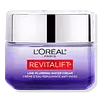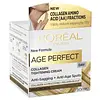What's inside
What's inside
 Key Ingredients
Key Ingredients

 Benefits
Benefits

 Concerns
Concerns

 Ingredients Side-by-side
Ingredients Side-by-side

Water
Skin ConditioningPropylene Glycol
HumectantGlycerin
HumectantDimethicone
EmollientAlcohol Denat.
AntimicrobialOctyldodecanol
EmollientCaprylyl Methicone
Skin ConditioningBetaine
HumectantNiacinamide
SmoothingIsohexadecane
EmollientHydroxypalmitoyl Sphinganine
Skin ConditioningSodium Acetylated Hyaluronate
HumectantSodium Hyaluronate
HumectantSodium Hydroxide
Buffering2-Oleamido-1,3-Octadecanediol
Skin ConditioningTocopheryl Acetate
AntioxidantCeramide NP
Skin ConditioningHydrogenated Lecithin
EmulsifyingAcrylates/C10-30 Alkyl Acrylate Crosspolymer
Emulsion StabilisingCarbomer
Emulsion StabilisingXanthan Gum
EmulsifyingDimethiconol
EmollientChlorphenesin
AntimicrobialPhenoxyethanol
PreservativeWater, Propylene Glycol, Glycerin, Dimethicone, Alcohol Denat., Octyldodecanol, Caprylyl Methicone, Betaine, Niacinamide, Isohexadecane, Hydroxypalmitoyl Sphinganine, Sodium Acetylated Hyaluronate, Sodium Hyaluronate, Sodium Hydroxide, 2-Oleamido-1,3-Octadecanediol, Tocopheryl Acetate, Ceramide NP, Hydrogenated Lecithin, Acrylates/C10-30 Alkyl Acrylate Crosspolymer, Carbomer, Xanthan Gum, Dimethiconol, Chlorphenesin, Phenoxyethanol
Water
Skin ConditioningSqualane
EmollientCyclohexasiloxane
EmollientGlycerin
HumectantCetyl Alcohol
EmollientGlyceryl Stearate
EmollientPEG-40 Stearate
EmulsifyingParaffinum Liquidum
EmollientMyristyl Myristate
EmollientDrometrizole Trisiloxane
UV AbsorberOctyldodecanol
EmollientJasminum Officinale Extract
MaskingStearyl Alcohol
EmollientIsobutane
Sorbitan Oleate
EmulsifyingSorbitan Tristearate
EmulsifyingCalcium Pantetheine Sulfonate
Skin ConditioningIsohexadecane
EmollientSodium Hydroxide
BufferingMyristyl Alcohol
EmollientCyclodextrin
AbsorbentMannitol
HumectantDisodium EDTA
Disodium Succinate
MaskingHydrolyzed Soy Protein
HumectantHydroxypalmitoyl Sphinganine
Skin ConditioningCapryloyl Salicylic Acid
ExfoliatingPentylene Glycol
Skin ConditioningFaex Extract
Skin ConditioningEthylhexyl Methoxycinnamate
UV AbsorberPolysorbate 80
EmulsifyingAcrylamide/Sodium Acryloyldimethyltaurate Copolymer
Emulsion StabilisingAcrylonitrile
Vp/Va Copolymer
Methylparaben
PreservativePhenoxyethanol
PreservativeChlorphenesin
AntimicrobialCI 15985
Cosmetic ColorantLinalool
PerfumingGeraniol
PerfumingAlpha-Isomethyl Ionone
PerfumingCoumarin
PerfumingLimonene
PerfumingCitronellol
PerfumingBenzyl Alcohol
PerfumingBenzyl Benzoate
AntimicrobialParfum
MaskingWater, Squalane, Cyclohexasiloxane, Glycerin, Cetyl Alcohol, Glyceryl Stearate, PEG-40 Stearate, Paraffinum Liquidum, Myristyl Myristate, Drometrizole Trisiloxane, Octyldodecanol, Jasminum Officinale Extract, Stearyl Alcohol, Isobutane, Sorbitan Oleate, Sorbitan Tristearate, Calcium Pantetheine Sulfonate, Isohexadecane, Sodium Hydroxide, Myristyl Alcohol, Cyclodextrin, Mannitol, Disodium EDTA, Disodium Succinate, Hydrolyzed Soy Protein, Hydroxypalmitoyl Sphinganine, Capryloyl Salicylic Acid, Pentylene Glycol, Faex Extract, Ethylhexyl Methoxycinnamate, Polysorbate 80, Acrylamide/Sodium Acryloyldimethyltaurate Copolymer, Acrylonitrile, Vp/Va Copolymer, Methylparaben, Phenoxyethanol, Chlorphenesin, CI 15985, Linalool, Geraniol, Alpha-Isomethyl Ionone, Coumarin, Limonene, Citronellol, Benzyl Alcohol, Benzyl Benzoate, Parfum
 Reviews
Reviews

Ingredients Explained
These ingredients are found in both products.
Ingredients higher up in an ingredient list are typically present in a larger amount.
Chlorphenesin is a synthetic preservative. It helps protect a product against bacteria in order to extend shelf life. In most cases, Chlorphenesin is paired with other preservatives such as phenoxyethanol and caprylyl glycol.
Chlorphenesin is a biocide. This means it is able to help fight the microorganisms on our skin. It is also able to fight odor-releasing bacteria.
Chlorphenesin is soluble in both water and glycerin.
Studies show Chlorphenesin is easily absorbed by our skin. You should speak with a skincare professional if you have concerns about using Chlorphenesin.
Learn more about ChlorphenesinGlycerin is already naturally found in your skin. It helps moisturize and protect your skin.
A study from 2016 found glycerin to be more effective as a humectant than AHAs and hyaluronic acid.
As a humectant, it helps the skin stay hydrated by pulling moisture to your skin. The low molecular weight of glycerin allows it to pull moisture into the deeper layers of your skin.
Hydrated skin improves your skin barrier; Your skin barrier helps protect against irritants and bacteria.
Glycerin has also been found to have antimicrobial and antiviral properties. Due to these properties, glycerin is often used in wound and burn treatments.
In cosmetics, glycerin is usually derived from plants such as soybean or palm. However, it can also be sourced from animals, such as tallow or animal fat.
This ingredient is organic, colorless, odorless, and non-toxic.
Glycerin is the name for this ingredient in American English. British English uses Glycerol/Glycerine.
Learn more about GlycerinHydroxypalmitoyl Sphinganine helps your skin create more ceramides. This ingredient has been shown to boost skin hydration and improve the skin barrier.
Your skin has an outermost layer called the stratum corneum. This is known as your skin barrier.
Your skin barrier consists of cholesterol (25%), free fatty acids (15%), and ceramides (50-60%). A healthy skin barrier is the key to hydrated and plump skin. Your skin is able to retain more moisture with a nourished barrier.
Although small, the skin barrier prevents bacteria and other bad things from going into our bodies. A damaged skin barrier can lead to itchy and dry skin, acne, or bacterial/viral/fungal skin infections.
Hydroxypalmitoyl Sphinganine tells your skin to create more ceramides. This helps fortify your skin barrier. Having a strong skin barrier leads to hydrated and healthy skin. More good news? You don't need a high amount of this ingredient to see benefits.
Hydroxypalmitoyl Sphinganine is created from a chemical reaction using an amino alcohol (dihydrosphingosine) and a fatty acid palmitic acid (2- 11 bromohexadecanoic acid).
Other ingredients that tell your skin to create more ceramide:
Learn more about Hydroxypalmitoyl SphinganineIsohexadecane is added to enhance texture, emulsify, and to help cleanse. It is an isoparrafin. It is a component of petrolatum.
Due to its large size, Isohexadecane is not absorbed by the skin. Instead, it sits on top and acts as an emollient. Emollients help keep your skin soft and smooth by trapping moisture within.
Isohexadecane is often used in products designed to help oily skin. It is lightweight and non-greasy while helping to moisturize. When mixed with silicones, it gives a product a silky feel.
Learn more about IsohexadecaneOctyldodecanol is a fatty alcohol. It is primarily used to enhance the texture of products.
As an emulsifier, Octyldodecanol helps prevent the oils and waters from separating. It also prevents ingredients from creating foam when shaken.
Octyldodecanol is created by reducing fatty acid to an alcohol.
Due to its high molecular weight, it does not get absorbed into the skin.
Learn more about OctyldodecanolPhenoxyethanol is a preservative that has germicide, antimicrobial, and aromatic properties. Studies show that phenoxyethanol can prevent microbial growth. By itself, it has a scent that is similar to that of a rose.
It's often used in formulations along with Caprylyl Glycol to preserve the shelf life of products.
Sodium Hydroxide is also known as lye or caustic soda. It is used to adjust the pH of products; many ingredients require a specific pH to be effective.
In small amounts, sodium hydroxide is considered safe to use. However, large amounts may cause chemical burns due to its high alkaline.
Your skin has a natural pH and acid mantle. This acid mantle helps prevent harmful bacteria from breaking through. The acid mantle also helps keep your skin hydrated.
"Alkaline" refers to a high pH level. A low pH level would be considered acidic.
Learn more about Sodium HydroxideWater. It's the most common cosmetic ingredient of all. You'll usually see it at the top of ingredient lists, meaning that it makes up the largest part of the product.
So why is it so popular? Water most often acts as a solvent - this means that it helps dissolve other ingredients into the formulation.
You'll also recognize water as that liquid we all need to stay alive. If you see this, drink a glass of water. Stay hydrated!
Learn more about Water